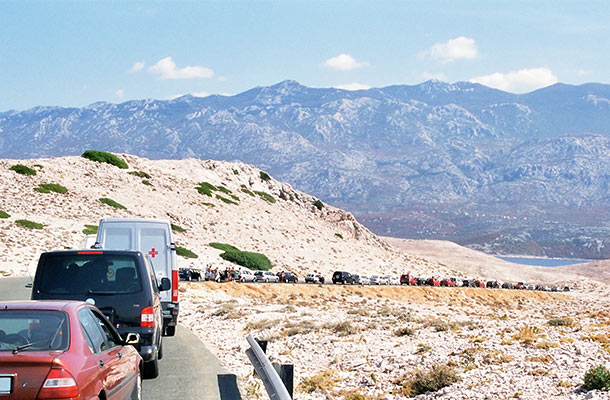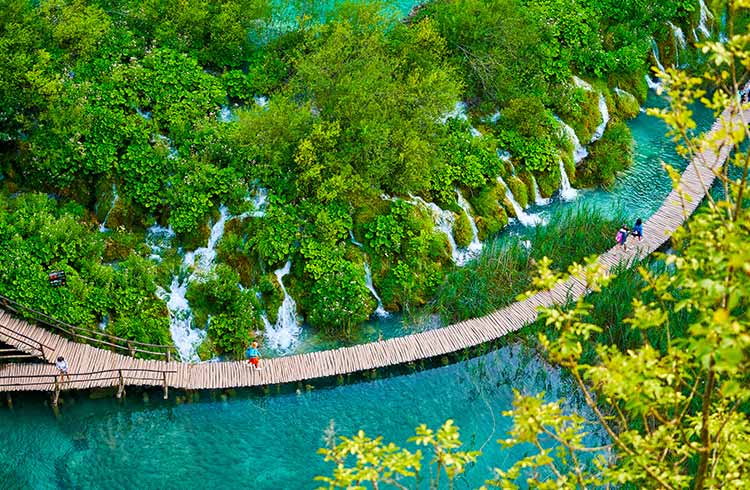Driving in Croatia: Road Rules and Tips for Travelers
With beautiful places to explore by car in Croatia, here are things to keep in mind as you drive down the Adriatic coast or through the mountains.
 Photo © iStock
Photo © iStock
- Driving on the right side of the road
- Driving tips for Croatia
- Staying safe on Croatia's roads
- Road rules in Croatia
Driving on the right side of the road
As in most European countries, Croatians drive on the right, not unusual for Americans and the majority of the world, but a bit scary for the Australians, New Zealanders, Brits, South Africans, and other left-siders.
Also be prepared for many of the features of the car, like headlights, turn indicators, and windshield wipers, to be in the reverse location. You'll get the hang of it after switching on the wipers instead of indicating a turn a few times.
Try remembering "fright right!", every time you give yourself a fright by not knowing which side of the road you're supposed to be on. You or a passenger screaming "fright, right" will set you on a proper course.
Driving tips for Croatia
Many travelers say that confidence is key on the narrow, winding Croatian roads.
Locals use their horns not only as a warning but as a greeting to other drivers, so don't be alarmed if you hear more car horns than a Los Angeles traffic jam.
Generally speaking, roads around Zagreb and other main towns are of a good standard and there are well-maintained motorways between the larger cities. However, rural areas and islands can be a different story. Smaller roads are often unlit at night, so take extra caution when driving in the dark.
If you're planning to take your car onto the islands, you will need to take one of the many car ferries that run from the mainland. Be sure to reserve your place on the ferry ahead of time, as on most services you can't just show up on the day. Some ferries enable you to book online but others you will need to book at a local ticket office.
Automatic cars are not as common in Croatia as they are in Australia or the United States, so unless you book well in advance you may end up testing your skills with a manual transmission. If you're not used to a manual car, this is not the time to learn.
Staying safe on Croatia's roads
Even if you consider yourself the next Max Verstappen, watch your speed and be wary of your fellow motorists. Croatian drivers love to overtake, even on tight corners, and are renowned for taking a bit of artistic license with the speed limit.
In the mountains and on the less populated areas of islands, roads are often very narrow and can sometimes only fit one car. Local drivers will try to pass you by, so just keep as close to your lane as possible.
Road accidents are common in Croatia. In 2023 Croatia had the fourth-highest number of road fatalities in Europe, according to the European Commission.
Planning a trip to Croatia? Find out how travel insurance can cover adventure activities, lost or stolen baggage, medical emergencies and more.
Road rules in Croatia
Many of the same road rules apply in Croatia as they do in other countries. Wear a seatbelt (it’s mandatory), don’t use your mobile phone while driving unless you have a hands-free device (it’s illegal), and don't get behind the wheel if you've been sampling the local beverages (there is a zero-tolerance alcohol policy for drivers under 25, and the limit is 0.05% for drivers over 25).
But be aware there are some laws that you may not be as used to. For instance, you’re required to use your daytime running lights during the day in winter (late October-April). Winter tires and carrying snow chains are mandatory from mid-November to mid-April.
When driving on mountain roads, uphill traffic has the right of way.
At intersections, the vehicle approaching from the right has the right of way. Turning right on a red light is illegal.
It’s compulsory to carry a fluorescent vest in your car (not the trunk/boot) while driving, and to wear it when changing a tire or attending to a breakdown. It’s also required to have a warning triangle and a first aid kit in the car when driving in Croatia.
If you get caught out on the road, emergency road help and towing is provided by the Croatian Automobile Club (HAK) which has English speaking operators. Contact them on +385 1 1987.
They also have a handy smartphone app which provides road information and conditions, roadside assistance links and more. Just make sure you pull over safely before using it!
Related articles
Simple and flexible travel insurance
You can buy at home or while traveling, and claim online from anywhere in the world. With 150+ adventure activities covered and 24/7 emergency assistance.
Get a quote

5 Comments
You don't have the kind of fun driving in Croatia offers very often in your life. Enjoy it.
Hi Team VisitCroatia,
I will be visiting Croatia and driving a bit in July second week.
1) will be taking the car from Opatija around 8am.
2) head to pula to see the amphitheatre
3) then from pula to plitvice and rest at the apartment for the rest of the day
4) will visit plitvice national park the next day
5) after visiting the park, head to zadar
6) do local sightseeing in zadar and rest for the day
7) next day, head to split, offload luggage at our apartment and return the car at split Airport
Need advise on this plan and the routes - opatija to pula, pula to plitvice, plitvice to zadar and zadar to split.
Also, I'm coming from a right hand drive country and it will be my first time with left hand drive! A bit anxious about that too!
Regards from India,
Ronak
Just returned from driving Croatia. Roads were excellent; smooth, well signed. But why o why didn't anyone warn of the wind gusts on the A1 from Zadar north to Zagreb? I thought I would be found with my tiny car at the bottom of a chasm. Gusts of between 90 and 100 kph, I'm guessing. Am not a religious person, but definitely saw God several times! Found out later that this is normal. They don't close the roads unless the wind exceeds 140 kph!! A totally terrifying, white knuckle experience.
Great article, thanks for the tips! Indeed, Croatia is home to a range of amazing landscapes that take visitors from the sparkling Adriatic Sea to the towering Dinaric Alps and is generally safe. However, there are still tourist-targeting scammers to be wary of. http://travelscams.org/europe/common-tourist-scams-Croatia/
Do be wary of the hostess bar scam, beach thieves, overcharging restaurants, pickpocketing, flat tire scam, overcharging taxi drivers, holiday apartment scam, car rental scam, border scam and many more!
Great point a couple comments up. I rented a tiny VW UP and driving from Zadar to Zagreb got caught in a torrential downpour with huge gusts of wind on an otherwise beautiful day. Would reccomend a little bigger car than the UP (yet it was perfect for cities like Zadar, Sibernik and Nin). And another, fairly important rule that isnt mentioned here; when leaving small towns along small highways they do not mark the start of new speed limits. You assume once you have left the town and it then becomes 80 with no notification. A few locals angrily passed a small VW UP going 50 in an 80....